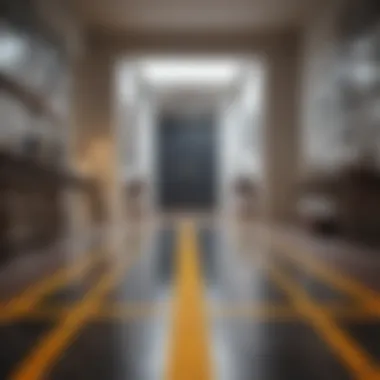Mastering Room Square Footage Calculation Techniques


Intro
Understanding how to calculate room square footage is not just a trivial pursuit; it serves a variety of practical needs. From evaluating property for sale in real estate to planning an effective layout in interior design, knowing the square footage of a room can inform crucial decisions. The methods and techniques employed can significantly affect the outcomes of projects in home improvement and architectural planning. This guide aims to clarify various measurement techniques, tools, and best practices, empowering readers with an understanding that transcends mere numbers.
As you progress through this article, expect insights that enrich your approach to space management. Whether you are a homeowner, a real estate professional, or a design enthusiast, recognizing the importance of accurate room dimensions will elevate your projects to new heights.
Prelude to Square Footage
Understanding square footage is vital for many areas of home and property management. This knowledge serves as a foundation for real estate evaluations, interior design, and various renovations. When one knows how to accurately measure and calculate square footage, it directly impacts decision-making regarding space utilization, value assessments, and aesthetic planning.
Definition of Square Footage
Square footage refers to the measurement of the area of a room, designated in square feet. To find square footage, one generally multiplies the length of a space by its width. For example, a room measuring 10 feet long and 12 feet wide has an area of 120 square feet. It provides a clear metric for both buyers and sellers in the real estate market. Knowing the square footage is crucial for accurate property listings and comparisons.
Importance of Accurate Measurements
Precision in measuring square footage is essential because even small errors can lead to significant implications. Accurate measurements help avoid misjudgments in property value, which can cost sellers. Additionally, for buyers, understanding specific dimensions allows for better fitting of furniture, appliances, and other elements necessary in a space.
Inaccurate measurements can lead to frustration during renovation or redesign projects. This can escalate costs and lengthen project timelines. Thus, having the right tools and methods to obtain reliable square footage measurements cannot be overstated.
Accurate room measurements reduce potential conflicts during property transactions and improve design outcomes.
To summarize, square footage is not merely a number; it is the cornerstone for various crucial applications in real estate and interior management. Familiarity with the concept and execution of precise measurements creates a pathway for informed choices amid personal and professional projects.
Understanding Room Dimensions
Understanding room dimensions is crucial when it comes to calculating square footage. It sets the foundation for many decisions in real estate, interior design, and even architectural planning. Accurate measurements affect the evaluation of a property’s value, its design layout, and the efficiency of space utilization. By grasping the basic principles behind measurements and room shapes, one can not only avoid mistakes but also enhance design choices and ensure compliance with standards.
The importance of spacing is often overlooked. However, a clear understanding of dimensions leads to effective planning and design. Without accurate room dimensions, estimating costs for renovations or understanding space for furniture placement can be challenging. Ultimately, mastering this aspect helps in making informed and strategic decisions in multiple domains.
Basic Geometric Principles
To accurately find room square footage, familiarity with basic geometric principles is necessary. Square footage is fundamentally a measure of area, which is calculated by multiplying the length and width of a room. This basic principle applies universally across various room shapes. Thus, understanding how to effectively measure the dimensions allows one to calculate the area with confidence and precision.
There are two primary units of measurement involved. Square footage is typically expressed in feet. Ensuring that all measurements are taken in the same unit is important to avoid confusion. Additionally, one should recognize that walls can affect measurements, particularly in irregularly shaped rooms.
Common Room Shapes
Different room shapes have unique characteristics. Recognizing these attributes aids in calculating area correctly and understanding how they affect design choices. Common room shapes include rectangular rooms, square rooms, and other irregular shapes. Each offers specific advantages and challenges.
Rectangular Rooms
Rectangular rooms are perhaps the most common in residential and commercial buildings. Their characteristic, straightforward geometry allows for easy calculation of square footage. To find the area, simply multiply the length by the width. This simplicity is a significant benefit for those measuring space.
Moreover, rectangular rooms often lend themselves well to furniture arrangement and functionality. They allow for a symmetrical layout, aiding in effective space management. However, depending on the length and width ratio, they may create a sense of monotony if not designed creatively.
Square Rooms
Square rooms feature equal length and width, which makes their area easy to calculate using the same basic formula: length times width. The symmetric nature of square rooms often creates a harmonious aesthetic. Additionally, this shape facilitates versatile furniture placements, accommodating different layouts and functional requirements.
However, one disadvantage may arise depending on usage; the equal dimensions can limit design creativity. People may find the setup to be less dynamic than in rectangular spaces. Yet, for specific applications like a studio or office, square dimensions can be ideal.
Other Shapes
In addition to rectangular and square rooms, there are various other shapes found in architectural designs. These can include triangular, circular, or more complex geometries. Each shape uniquely contributes to the overall space management. Calculating square footage in non-standard shapes can be more challenging.
For example, triangular rooms require different formulas to calculate area. Similarly, circular rooms use a distinct approach based on radius. The benefit of these shapes often lies in their distinctiveness, which can contribute to a unique interior design. However, they can complicate furniture placement and functionality for inhabitants.


Understanding these types of room shapes informs better design and renovation decisions. It also enhances productivity when it comes to managing space and adherence to intended layouts. This knowledge reinforces not only the accuracy of calculations but also elevates the design experience overall.
"Accurate room measurements lead to better decision-making in real estate, design, and renovation projects."
In summary, the ability to effectively understand and measure room dimensions provides individuals with the tools necessary to achieve accurate square footage calculations. Whether dealing with simple shapes or more complex designs, this knowledge is essential.
Measuring Techniques
Tools Required for Measurement
Tape Measures
Tape measures are perhaps the most familiar tools for measuring space. They are favored for their simplicity and ease of use. A high-quality tape measure can often extend to lengths of 25 to 30 feet. This range is particularly helpful for standard room dimensions. The key characteristic of tape measures is their flexible metal or fabric tape, which makes it adaptable to different room shapes. However, there are certain downsides. One significant disadvantage is their potential inaccuracy if not properly reset or held snug against the wall. Relying solely on them for large areas without verification may lead to mistakes. Nevertheless, tape measures remain a common choice due to their accessibility.
Laser Distance Measurer
The laser distance measurer is a modern alternative that enhances measuring accuracy. This device uses laser technology to determine distances quickly and precisely. The key advantage of laser distance measurers is their ability to capture measurements over longer distances without the need to physically stretch tape. This technology can be particularly beneficial in large spaces or complex layouts where traditional measuring methods fall short. However, these devices can be more expensive and require a power source or charged batteries. Despite the cost, for those prioritizing speed and accuracy, laser distance measurers are an excellent option.
Smartphone Apps
Smartphone apps have emerged as useful tools for measuring room dimensions. These applications turn your mobile device into a measurement tool by utilizing the camera and built-in sensors. The key characteristic is convenience; having a measurement tool at your fingertips is practical for quick assessments. Many apps can even calculate area and volume right away. However, accuracy can be variable depending on the model of the smartphone and the app’s design. Some users may find these apps can miss nuances in room features, so they should not be relied upon exclusively. Nonetheless, for a fast overview or if someone is already using their smartphone for other tasks, these apps represent a modern solution.
Step-by-Step Measurement Process
To measure a room’s square footage effectively, the following step-by-step process is recommended:
- Gather Your Tools: Collect a tape measure, laser distance measurer, or smartphone app, as suitable.
- Clear the Area: Make sure the space is clutter-free to allow for easier access.
- Measure Length and Width: For rectangular or square rooms, measure the longest and widest points. It is important to measure the room at the floor level, ensuring the tape measure or laser is level.
- Record Measurements: Write down the length and width for each room or section clearly to avoid confusing data.
- Calculate Square Footage: Multiply the measured length by the width. For instance, if your measurements are 12 feet in length and 10 feet in width, your calculation would be:
- Review and Adjust: It’s wise to double-check your measurements to ensure accuracy.
By following these steps and utilizing the appropriate tools, individuals can derive accurate room dimensions, facilitating effective planning and design for various projects.
Calculating Square Footage
Calculating square footage is an essential skill, particularly within the realms of real estate, design, and any space planning endeavors. This process not only facilitates accurate property assessments but also informs decisions related to renovations, furnishing, or modifications. Understanding square footage can influence everything from buying and selling properties to arranging furniture and optimizing room functionality.
Additionally, knowing how to calculate square footage accurately can prevent costly mistakes. An incorrect measurement might lead to purchasing inadequate flooring or wallpaper. Thus, it becomes critical to approach this process with precision and clarity.
The subsequent sections will dissect the formula for square footage calculations, offering examples to cement this understanding and illustrate practical application.
Formula for Square Footage
The primary formula to calculate square footage is straightforward:
Square Footage = Length × Width
Here, length and width should be measured in feet. To demonstrate, if a room measures 15 feet in length and 10 feet in width, the calculation would be:
[ 15 ext ft imes 10 ext ft = 150 ext sq ft ]
It is crucial that measurements are recorded accurately since any inaccuracies can affect the final area calculation. For rooms with irregular shapes, the total area can be determined by breaking the space down into smaller rectangles or squares, calculating the square footage for each, and then summing those values.
Examples of Square Foot Calculations
Examining specific cases can enhance your grasp of square footage calculations. Below are various scenarios to illustrate how to effectively apply the formula:
- Rectangular Room: A room measuring 20 feet long and 12 feet wide would yield:
- Square Room: For a square room with each side measuring 10 feet:
- L-Shaped Room: This requires some extra steps. Assuming one section is 10 feet by 15 feet and the other is 5 feet by 10 feet:
- Calculation: 20 × 12 = 240 sq ft


- Calculation: 10 × 10 = 100 sq ft
- First section: 10 × 15 = 150 sq ft
- Second section: 5 × 10 = 50 sq ft
- Total area: 150 + 50 = 200 sq ft
Each example demonstrates the calculation method clearly and emphasizes the importance of precision. For further details and additional resources, you may refer to articles on measurements at Wikipedia or Britannica.
Considerations in Measurement
When measuring room square footage, certain considerations impact the overall accuracy of your calculations. This section delves into how architectural features and the complexities of multi-level spaces affect measurements. Understanding these elements is vital for achieving precise results that can serve various purposes, such as real estate evaluations and home renovation projects.
Influence of Architectural Features
Architectural features can greatly influence the effective square footage of a room. Understanding these features can lead to more accurate calculations and ultimately a better design or valuation.
Built-in Furniture
Built-in furniture is a critical aspect to consider when measuring square footage. These pieces, such as shelves or cabinets integrated into the structure of a room, can alter usable space. The key characteristic of built-in furniture is that it modifies the flow and utility of the room. For instance, a wall unit may consume a portion of the wall area, thus impacting how one calculates the space available for other uses. Although favored for their efficiency, built-in furniture may reduce the overall usable square footage of a room if not properly accounted for during measurement.
- Advantages of built-in furniture include:
- Disadvantages may consist of:
- Efficient use of space
- Aesthetic enhancement of the room
- Potential increase in property value
- Complications in measurement
- Limited adaptability to room changes
Niches and Alcoves
Niches and alcoves are unique architectural features that can add character to a room. They often serve decorative or functional purposes, like housing artwork or providing additional seating. In terms of square footage calculation, they present both benefits and challenges. Niches can create visually appealing elements while also subtracting from the floor area used in standard measurements.
The key characteristic of niches and alcoves is that they can enhance a room's aesthetic but might complicate the total square footage calculation. Evaluating them accurately is crucial for proper space planning.
- Advantages of niches and alcoves include:
- Challenges involve:
- Enhanced visual interest
- Potential for creative design solutions
- Space-saving opportunities
- Difficulty in accurately measuring the area they occupy
- Possible confusion about how to integrate them into overall square footage calculations
Measurement in Multi-Level Spaces
Multi-level spaces, such as split-level homes or buildings with lofts, present additional complexity for accurate square footage measurement. These structures may have varying ceiling heights and unique layouts that influence how measurements are recorded and utilized.
When engaging with these spaces, it's essential to approach the measurement with care. Here are some important aspects to consider:
- Measure each level independently and sum the square footage for the entire area.
- Be mindful of how sloped ceilings and varying floor areas can affect calculations.
- Use consistent units of measurement throughout the process to avoid confusion.
In multi-level contexts, accurate measurement is critical for evaluations that impact resale value, since appraisers will look at usable square footage in relation to features like living space and layout efficiency. This consideration aligns well with the overall goal of understanding space management, providing clarity for potential buyers and sellers alike.
Applications of Room Square Footage
Understanding room square footage is vital in various contexts, each with its distinct requirements and implications. The significance of accurate measurement transcends mere numerical values; it influences decisions in real estate, interior design, and home renovation.
By grasping the applications of square footage, individuals can make informed choices that serve their specific needs. This section will delve into three primary applications: real estate evaluations, interior design planning, and home renovation projects.
Real Estate Evaluations
In the realm of real estate, square footage is a fundamental metric used to determine a property's value. Buyers and sellers alike rely on this data, as larger homes often command higher prices. Accurate measurement helps to establish not only the market price but also the competitive positioning of a property within the market.
For real estate agents and appraisers, it is crucial to provide precise measurements. Miscalculating square footage can lead to discrepancies that impact negotiations adversely, causing financial setbacks for sellers and misleading buyers. Evaluating square footage accurately allows real estate professionals to produce trustworthy reports. Here are a few considerations:
- Be consistent with measurement techniques used across listings.
- Familiarize yourself with local regulations on how square footage should be calculated.
- Communicate any measurement variations to potential buyers clearly.


Interior Design Planning
In interior design, the understanding of room square footage is essential for creating functional and aesthetically pleasing spaces. Designers use this information to optimize layouts, ensuring that furniture and decor fit harmoniously within the available area. The flow and usability of a room depend heavily on the effective use of square footage.
When planning interior spaces, it is important to consider:
- Space allocation: Identifying how to use each inch of a room effectively.
- Furniture dimensions: Ensuring that furniture complements the room's scale without overcrowding.
- Zoning areas: Creating distinct functional zones, such as dining, lounging, or workspace areas, based on the available square footage.
With precise measurements, interior designers can produce plans that enhance livability and style, resulting in satisfied clients.
Home Renovation Projects
Homeowners undertaking renovation projects must consider room square footage for budgeting and design purposes. Knowing the exact size of a room can dictate the scope of work, the amount of materials needed, and the corresponding costs. Renovations often require permits that reference accurate measurements.
When planning renovations, homeowners should keep a few factors in mind:
- Material estimation: Accurate square footage helps calculate the quantity of paint, flooring, or wall materials required.
- Budgeting: Knowing the area allows for a more realistic budget to be set.
- Impact on property value: Well-planned renovations can increase a home's value, making proper measurements even more critical.
Ultimately, correct square footage calculations form the cornerstone of successful renovations, ensuring that both aesthetic and functional goals are met.
Accurate square footage is not just a number; it’s a fundamental aspect that shapes many decisions in real estate, design, and renovations.
Common Mistakes in Measurement
Accurately measuring room square footage is crucial. However, many people make basic mistakes that can lead to incorrect calculations. Understanding common pitfalls can enhance precision and provide a clear picture of available space. This section discusses important errors, helping you achieve reliable measurements.
Underestimating Room Dimensions
A frequent error occurs when individuals underestimate room dimensions. This might happen if one relies solely on memory or estimates rather than taking proper measurements. Without accurate dimensions, the subsequent area calculation becomes flawed. For example, a small living room might seem to have the dimension of 10 feet by 12 feet, but without measuring, it could actually be larger.
Consequences of underestimating room size include:
- Impact on Design: Interior design may fail to consider storage needs or furniture arrangements.
- Real Estate Value: Inaccurate square footage can misrepresent property value, affecting buying or selling decisions.
- Renovation Issues: Underestimations can lead to shortages in materials or misaligned plans.
To avoid this, always measure the room. Use a tape measure or laser tool and document the dimensions carefully. Make sure to double check the numbers.
Ignoring Architectural Elements
Another mistake is ignoring architectural elements in measurement. Built-in shelves, niches, and alcoves greatly influence usable space, yet many neglect to account for these features. This oversight can significantly alter the square footage calculation. For instance, a room that measures 15 feet by 20 feet gives a square footage of 300. However, if built-ins occupy space, the effective square footage decreases.
Key considerations include:
- Built-in Furniture: These elements should be included in calculations to reflect true dimensions.
- Niches and Alcoves: Recessed areas can impact usability and overall space perception.
- Doors and Windows: Ensure to consider how these features affect arrangement and usable space.
By accurately noting architectural elements, you will provide a complete overview of a room’s square footage. Always factor in these elements while planning or designing spaces.
Remember: Accurate measurement is not just about square footage—it's about understanding the complete context of your spaces.
End
In this article, we have explored the intricate process of calculating room square footage. Understanding how to measure square footage accurately is fundamental for various practical applications, including real estate assessments, interior design, and home renovations. The significance of precise measurements cannot be overstated, as they directly affect project planning, space utilization, and property valuations.
Summary of Key Points
To summarize, the critical components of finding room square feet include:
- Understanding dimensional factors: Grasping the geometric principles and common room shapes.
- Measuring techniques: Utilizing appropriate tools such as tape measures and laser distance measurers.
- Calculating square footage: Applying formulas accurately based on the measurements obtained.
- Avoiding common mistakes: Being aware of pitfalls such as underestimating dimensions or ignoring architectural features.
By adhering to these objectives, one can ensure that their measurements are reliable and truly represent the area in question.
Final Thoughts on Accurate Measurement
Accurate measurement is not merely about numbers; it reflects the intention behind space utilization. Whether it is for assessing property value or optimizing interior design projects, every square foot matters significantly. Taking precise measurements allows for informed decisions, ultimately leading to better living environments and investment outcomes.
As you refine your skills in measuring square footage, remember that consistency and attention to detail are your allies. Utilize the methods and techniques discussed in this guide, ensuring that your spatial awareness builds a strong foundation for your projects and aspirations.















